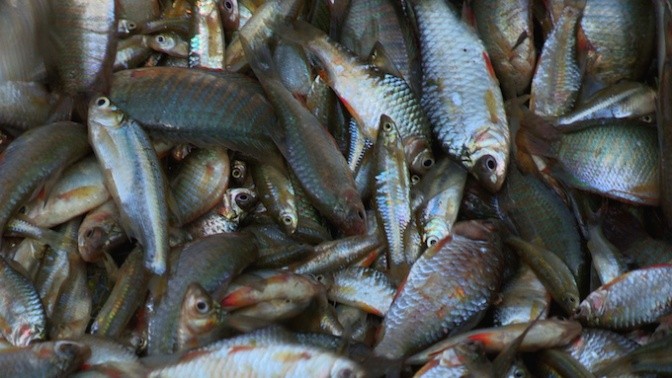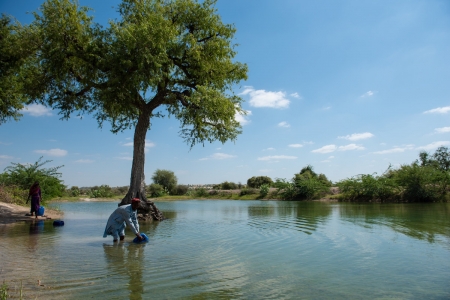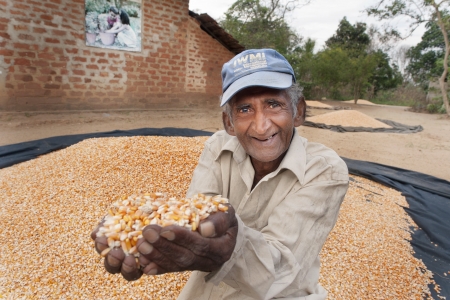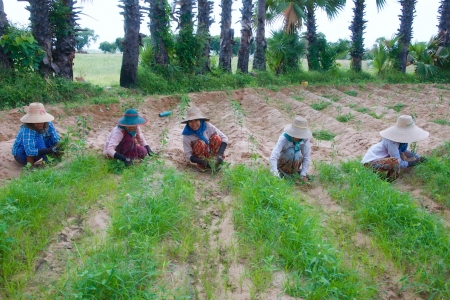By Michael Victor and Ilse Pukinskis
Communicating an “ecosystem-based approach to more sustainable agriculture” can be as difficult as it sounds. Often, national level officials confuse this with ‘conservation’ – a big bad word in countries where development is the primary concern. At other times, it has been hard to distinguish an ecosystem-based approach from other approaches such as sustainable intensification and organic agriculture.
 Photo: Doug Varchol
Photo: Doug VarcholBut there are differences, and one of the keys to better communicating the ecosystem-based approach is to identify good stories that show the approach in practice.
A new film, produced by Douglas Varchol, puts the spotlight on one research project that demonstrates how sometimes the ‘big win’ is actually the result of the convergence of many small interventions. The project approached the challenge of improving inland fisheries in Bangladesh from a number of angles that not only acknowledged the prevailing social system, market and ecosystem dynamics, but also recognized the importance of addressing each one.
The project, entitled ‘Floodplain Fisheries and Aquaculture in Bangladesh and India’, was funded by the CGIAR Research Program on Water, Land and Ecosystems (WLE) and carried out by WorldFish. It drew upon ten years of previous work to demonstrate the social and environmental benefits of properly managed, community-based fish culture.
In the Ganges Brahmaputra floodplain of north-western Bangladesh thousands of beels (lake-like bodies of static water) form an extensive inland open water fisheries system. Floodplains provide a diverse range of livelihood and ecosystem services for local communities but are under increasing stress from pollution, overfishing and infrastructure development. Fishing in the beels is primarily managed by community-fishing cooperatives, whose membership excludes the poorest members of society.
In terms of biodiversity and fish production, these inland open-water fisheries are the third richest in the world after China and India. They are responsible for almost 30% of the country’s fish production, with more than 8 million people depending on them for their livelihoods.
Dr. Benoy Barman of WorldFish, the principle researcher on the project, explains, “Floodplains are very important because during the dry months they produce a lot of crops, but in the wet months they produce large amounts of fish.”
The film highlights ways that we can balance these different systems to ensure good crop and fish yields while also maintaining the health of the beels. The main messages that emerge from the film highlight some of the primary components of a successful ecosystem-based approach.
Message 1: Use an adaptive management approach
The researchers in the beels took an adaptive management approach, meaning that they did not come into the research with a pre-conceived solution. Instead, they examined the social and ecological systems in the beels, designed potential interventions and then initiated a process of implementation, reflection and adaptation of interventions as the project progressed. One early innovation concerned a floating plant called shola that was found to be beneficial for a healthy fish population. The project worked with the fishing cooperatives to plant shola prior to the start of the fishing season and experienced a subsequent increase in fish productivity.
Message 2: Focus on livelihoods, not just productivity
The second message is to look for ways to not only increase aggregate yields but also focus on how agriculture and aquaculture can improve livelihoods. The team first tried providing large fingerlings to the cooperatives at the beginning of the season, as the fingerlings grew quickly and could be sold for more money. But it was also discovered that small fish natural to the floodplain were more important than anyone had ever imagined.
Stocking small fish, such as the indigenous mola, and installing fences that allowed the small fish to navigate through the barriers that kept the large fingerlings confined revealed additional benefits to the local communities. It increased the number of indigenous species in the floodplain, thereby creating a healthier ecosystem and a more productive fishery. In turn, the resulting overabundance of small fish generated an important source of food and income for the poorest members of the communities.
Message 3: Take social dynamics and issues of equity into account
The final message underscores the importance of taking into account social dynamics and issues of equity when conducting research-for-development projects. The research team worked with the communities to develop a system whereby the fishing coops (made up of land owners and professional fishers) grant permission to landless community members to harvest the small fish using traditional gear. This sharing of benefits improved the livelihoods of the poorer members of the communities and fostered community harmony.
“In communities that allow such a system, it is obvious that there is more social cohesion and community participation. The challenge now to figure out how we scale this up and out”, says Barman
In the communities that participated in the project, the system is more resilient than before; more indigenous fish create more biodiversity, which in turns allows for diversified and increased production. The communities are not dependent on one golden crop.
In almost all cases, the ecosystem-based approach to agriculture does not provide a quick fix. And often it doesn’t provide the attention-grabbing headline that accompanies technological breakthroughs. But for the people that depend on the beels of Bangladesh, an ecosystem-based approach has provided them with more than a quick fix—it has given them the tools to thrive.
WLE is looking for good examples of how ecosystem-based approaches can improve livelihoods and boost productivity. If you have others let us know!
For more information on the project: “Floodplain Fisheries and Aquaculture in Bangladesh and India”.









Comments
This is a great example of how to work in complex environments. This systemic approach is defined in ‘Validating Strategies', joining-up the public and private organisations. Creating ‘True’ strategies that answer; what do customers (citizens and communities) want to ‘do’.
Very few community benefits can be achieved through a single agency, collaborations are essential. These are often complex and to succeed the complexity needs to be recognised and simple rules adopted.
The OpenStrategies approach recognizes that ‘anyone can design a complicated strategy system but a good designer will develop a simple one’. The resulting OpenStrategies’ system is compellingly simple yet powerful, even for very complex, large scale strategies. Crucially, OpenStrategies doesn’t just underpin the design of strategies – it also guides their validation and implementation.
OpenStrategies gives you a validated strategy with a rationale AND an Action Plan.
The founding challenge “If it is possible to use open source paradigms and processes to write software, then is it possible to use open source paradigms and processes to develop strategies?”. Validating Strategies shows that adopting these paradigms will improve wealth creating for the 21st century organisations and their communities.
Recent publications:
The OpenStrategies approach can be explored at the Validating Strategies website https://openstrategies.com/ and through the book: Validating Strategies - Linking Projects and Results to Uses and Benefits, published by Gower https://www.gowerpublishing.com/isbn/9781472427816, this web page allows you to read the Preface and Introduction.
A) Why most public sector strategies aren't actually strategies at all - Guardian 8 April 2014
https://www.theguardian.com/public-leaders-network/2014/apr/08/public-sec...
Very nice movie and blog piece, thanks Ilse and Michael ! And please to see the efforts of our colleagues in Bangladesh highlighted here.
As you noted this project did not come out of the blue. Indeed, like many other ecosystem based innovations, drew upon 10 years of previous research within CPWF, the CGIAR Challenge Program on Water and Food. The project depicted here was actually one of the 4 Research into Use projects designed by CPWF during its second phase, and funded by the CGIAR Research Program on Water, Land and Ecosystems, as a financial counterpart of an IFAD large grant on Mainstreaming Innovations from CPWF.
Information on other CPWF Research into Use projects can be found here :
Benefits of shallow groundwater irrigation
Uptake of integrated termite management for rehabilitation of degraded rangeland in Eastern Africa
Companion Modelling at Sub-Basin Scale